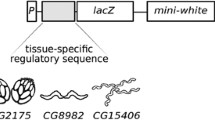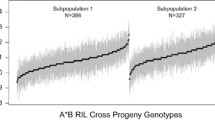Abstract
We wanted to determine whether there is a correlation between the quantitative character, the penetrance of the loss of humeral bristles in scute lines, and the distribution of transposable genetic elements in their genomes. We derived 18 isogenic lines with penetrance ranging between 2.8% and 92.0% from six mutant lines. The localization of the transposable elements (TEs) P, mdg1, Dm412, copia, gypsy and B104 was determined in all isogenic derivatives by in situ hybridization. The total number of the TE sites over all lines was 180. A comparison of the distribution of the TEs in the isogenic lines revealed the location of sites typical of lines with similar penetrance, no matter which parental line was involved. The results obtained suggest that such typical sites appear to tag the genome regions where the polygenes affecting the character in question are most likely to be found.
Similar content being viewed by others
References
Biemont C, Terzian C (1988) Mdg-1 mobile element polymorphism in selected Drosophila melanogaster populations. Genetica 76:7–14
Biemont C, Belyaeva ES, Pasyukova EG, Kogan GL (1985) Mobile gene localization and viability in Drosophila melanogaster. Experentia 41:1474–1476
Bingham P, Levis R, Rubin G (1981) Cloning of DNA sequences from the white locus of D.melanogaster by a novel and general method. Cell 25:693–704
Campuzano S, Carramolino L, Cabrera CV, Ruiz-Gomes M, Villares R, Boronat RA, Modolell J (1985) Molecular genetics of the achaete — scute gene complex of Drosophila melanogaster. Cell 40:327–338
Eanes W, Wesley C, Hey J, Houle D, Ajioka JW (1988) The fitness consequences of P-element insertions in Drosophila melanogaster. Genet Res 52:17–26
Fraser AS, Scowcroft W, Nassar R, Angeles H, Bravo C (1965) Variation of scutellar bristles in Drosophila melanogaster. IV. Effect of selection. Aust J Biol Sci 18:619–641
Furman DP (1993) Characterisation of the scute mutations in Drosophila melanogaster induced in the P-M system of hybrid dysgenesis. Siberian Biol Jour 5:3–9
Furman DP (1994) Properties of the scute mutations in Drosophila melanogaster induced in the P-M system of hybrid dysgenesis. Dros Inf Serv 75:72–75
Furman DP, Rodin SN, Kozhemyakina TA (1993) Mobile elements distribution and quantitative character penetrance in the scute mutants of Drosophila melanogaster induced in the system of P-M hybrid dysgenesis. (in Russian) Genetika 29:960–977
Call JG, Pardue ML (1971) Nucleic acid hybridization in cytological preparations. Methods Enzymol 21:470–480
Hunt JA, Bishop JG, Carson HL (1984) Chromosomal mapping of a middle-repetitive DNA sequence in a cluster of five species of Hawaiian Drosophila. Proc Natl Acad Sci USA 81:7146–7150
Kaidanov LZ, Bolshakov VN, Tzygvintzev PN, Gvozdev VA (1991) The sources of genetic variability in highly inbred long-tern selected strains of Drosophila melanogaster. Genetica 85:73–78
Lai C, Mackay TFC (1990) Hybrid dysgenesis-induced quantitative variation on the X chromosome of Drosophila melanogaster. Genetics 124:627–636
Lefevre GJ (1976) A photograph representation and interpretation of the polytene chromosomes of Drosophila melanogaster salivary glands. In: Ashburner M, Novitsky E (eds) Genetics and biology of Drosophila vol. 1a, Academic Press, London pp 31–36
Leynes L, Dambley-Chaudiere C, Ghysen A (1989) Two different sets of cis elements regulate scute to establish two different sensory patterns. Roux's Arch Dev Biol 198:227–232
Lindsley DL, Grell EH (1968) Genetic variations of Drosophila melanogaster. Carnegie Inst Wash Publ 627
Mackay TFC (1984) Jumping genes meet abdominal bristles:hybrid dysgenesis-induced quantitative variation. Genet Res 44:231–237
Mackay TFC (1985) Transposable element response to artificial selection in Drosophila melanogaster. Genetics 111:351–374
Mackay TFC (1989) Transposable elements and fitness in Drosophila melanogaster. Genome 31:284–295
Mackay TFC, Lyman RF, Jackson MS (1992) Effects of P-element insertion on quantitative traits in Drosophila melanogaster. Genetics 130:315–332.
Mather K, Jinks JL (1982) Biometrical genetics. Chapman and Hall, London
Ratner VA, Vasilyeva LA (1992) Mobile genetic elements (MGEs) and quantitative characters of Drosophila: the facts and hypothesis (in Russian). Genetika 28:15–27
Ruiz-Gomes M, Modolell J (1987) Deletion analysis of the achaetescute locus of D.melanogaster. Genes Dev 1:1238–1246
Shrimpton AE, Mackay TFC, Leigh-Brown AJ (1990) Transposable element-induced response to artificial selection in Drosophila melanogaster:molecular analysis of selection lines. Genetics 125:803–811
Thompson JN Jr, Hellack JJ, Tucker RR (1991) Evidence for balanced linkage of X-chromosome polygenes in a natural population of Drosophila. Genetics 127:117–123
Zharkikh AA, Rzshetsky AYu, Morozov PM et al. (1991) VOSTORG:a package of microcomputer programs for sequence analysis of phylogenic trees. Gene 101:251–254
Author information
Authors and Affiliations
Additional information
Communicated by G. Wenzel
Rights and permissions
About this article
Cite this article
Furman, D.P., Rodin, S.N. & Kozhemiakina, T.A. Transposable elements and the penetrance of quantitative characters in Drosophila melanogaster . Theoret. Appl. Genetics 91, 1095–1100 (1995). https://doi.org/10.1007/BF00223925
Received:
Accepted:
Issue Date:
DOI: https://doi.org/10.1007/BF00223925




